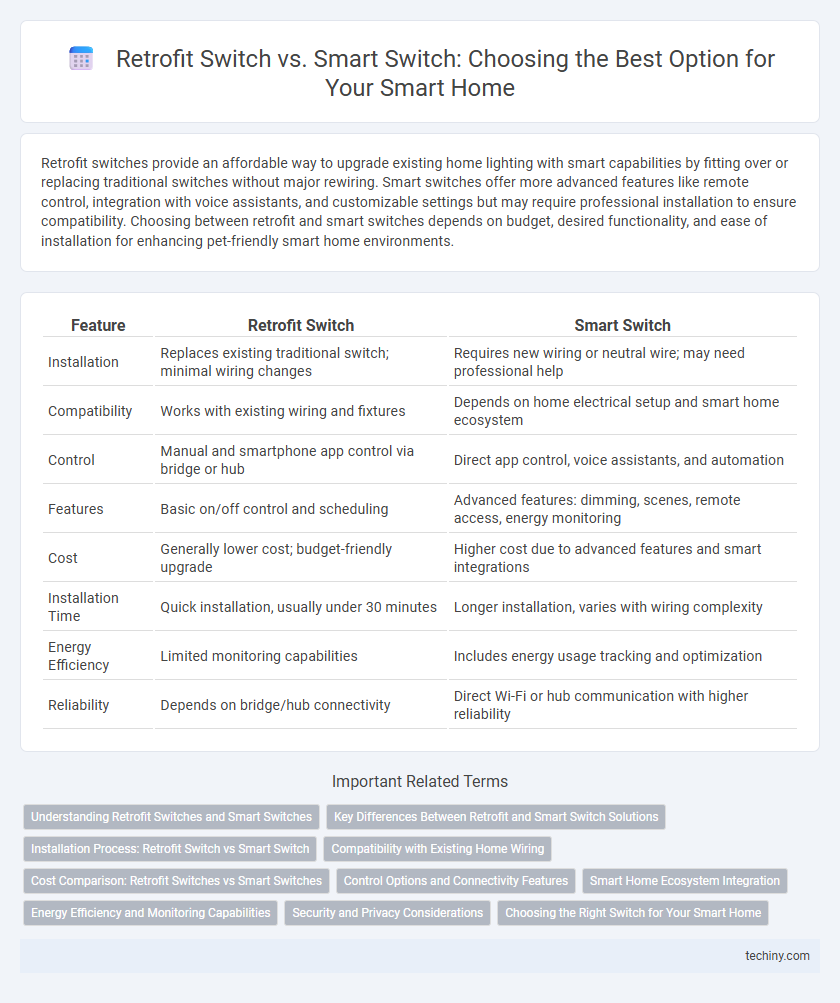Retrofit switches provide an affordable way to upgrade existing home lighting with smart capabilities by fitting over or replacing traditional switches without major rewiring. Smart switches offer more advanced features like remote control, integration with voice assistants, and customizable settings but may require professional installation to ensure compatibility. Choosing between retrofit and smart switches depends on budget, desired functionality, and ease of installation for enhancing pet-friendly smart home environments.
Table of Comparison
| Feature | Retrofit Switch | Smart Switch |
|---|---|---|
| Installation | Replaces existing traditional switch; minimal wiring changes | Requires new wiring or neutral wire; may need professional help |
| Compatibility | Works with existing wiring and fixtures | Depends on home electrical setup and smart home ecosystem |
| Control | Manual and smartphone app control via bridge or hub | Direct app control, voice assistants, and automation |
| Features | Basic on/off control and scheduling | Advanced features: dimming, scenes, remote access, energy monitoring |
| Cost | Generally lower cost; budget-friendly upgrade | Higher cost due to advanced features and smart integrations |
| Installation Time | Quick installation, usually under 30 minutes | Longer installation, varies with wiring complexity |
| Energy Efficiency | Limited monitoring capabilities | Includes energy usage tracking and optimization |
| Reliability | Depends on bridge/hub connectivity | Direct Wi-Fi or hub communication with higher reliability |
Understanding Retrofit Switches and Smart Switches
Retrofit switches replace existing traditional switches without rewiring, integrating smart functionality while maintaining the original wall plate and wiring, making installation quick and cost-effective. Smart switches, on the other hand, often require neutral wires and new wiring setups, offering advanced features like remote control, automation, and voice assistant compatibility. Understanding the differences in installation requirements and compatibility with home electrical systems helps in choosing the right smart home upgrade.
Key Differences Between Retrofit and Smart Switch Solutions
Retrofit switches are designed to replace existing light switches without rewiring, offering basic remote control and automation features compatible with older electrical setups. Smart switches require a neutral wire for installation, providing advanced functionalities like voice control, scheduling, and integration with smart home ecosystems such as Alexa, Google Home, and Apple HomeKit. Key differences include installation complexity, compatibility with home wiring, and the breadth of smart features available, with smart switches generally offering a more seamless and feature-rich user experience.
Installation Process: Retrofit Switch vs Smart Switch
Retrofit switches typically install directly onto existing wiring and traditional switch plates, allowing for a straightforward, tool-based replacement without rewiring. Smart switches often require a neutral wire and may need more extensive electrical knowledge or professional installation to integrate fully with home automation systems. Choosing between retrofit and smart switches depends on the home's wiring configuration and the desired level of smart home functionality.
Compatibility with Existing Home Wiring
Retrofit switches are designed for seamless integration with existing home wiring, allowing homeowners to upgrade to smart technology without rewiring or extensive electrical work. Smart switches often require a neutral wire, which may not be present in older homes, potentially complicating installation. Selecting retrofit switches ensures compatibility with a wide range of traditional wiring setups, providing a practical solution for older properties.
Cost Comparison: Retrofit Switches vs Smart Switches
Retrofit switches typically cost between $20 and $50, making them a budget-friendly option for upgrading existing wiring without extensive electrical work. Smart switches, priced around $40 to $100, offer integrated smart features such as Wi-Fi connectivity and app control, but often require compatible wiring and possibly professional installation. Choosing between retrofit and smart switches depends on balancing upfront costs with desired functionality and installation complexity.
Control Options and Connectivity Features
Retrofit switches enable smart control by integrating with existing wiring, offering manual toggle and app-based control through hub connectivity, often using Z-Wave or Zigbee protocols. Smart switches feature built-in Wi-Fi or Bluetooth, allowing direct smartphone control, voice assistant compatibility, and remote access without additional hubs. Both options support automation, but smart switches provide more seamless connectivity and advanced control features for modern smart home systems.
Smart Home Ecosystem Integration
Retrofit switches offer basic automation by replacing traditional toggles without requiring rewiring, but often lack seamless compatibility with diverse smart home ecosystems. Smart switches are designed for full integration with platforms like Amazon Alexa, Google Home, and Apple HomeKit, enabling centralized control, voice commands, and automation routines. Choosing smart switches enhances the scalability and interoperability of a smart home system, supporting advanced features like scene control and energy monitoring.
Energy Efficiency and Monitoring Capabilities
Retrofit switches enhance energy efficiency by enabling remote control and scheduling of existing lighting systems without rewiring, reducing unnecessary power consumption. Smart switches offer advanced energy monitoring capabilities, providing real-time data and analytics to optimize usage and identify energy-saving opportunities. These devices integrate seamlessly with home automation platforms, allowing users to track and manage energy consumption more effectively.
Security and Privacy Considerations
Retrofit switches offer basic remote control but often lack advanced encryption, making them more vulnerable to hacking compared to dedicated smart switches. Smart switches typically incorporate robust security protocols such as WPA3, firmware updates, and device authentication to protect user data and ensure network integrity. Choosing smart switches enhances privacy by enabling local processing and secure cloud interactions, reducing exposure to unauthorized access.
Choosing the Right Switch for Your Smart Home
Retrofitting your existing switch offers a cost-effective way to integrate smart home features without rewiring, preserving the original wall aesthetics and functionality. Smart switches provide enhanced capabilities such as remote control, scheduling, and voice assistant compatibility but typically require neutral wiring and professional installation. Assess your home's wiring, budget, and desired smart features to determine whether a retrofit switch or a fully integrated smart switch best suits your smart home setup.
Retrofit Switch vs Smart Switch Infographic

 techiny.com
techiny.com